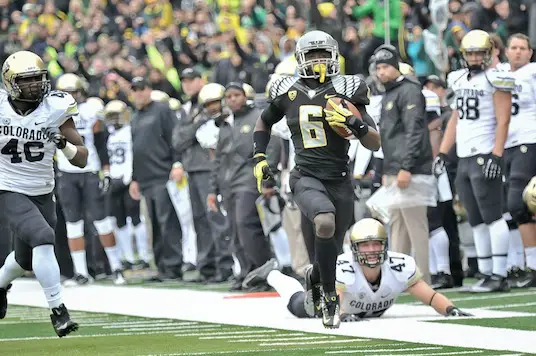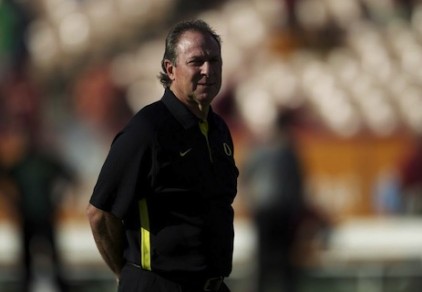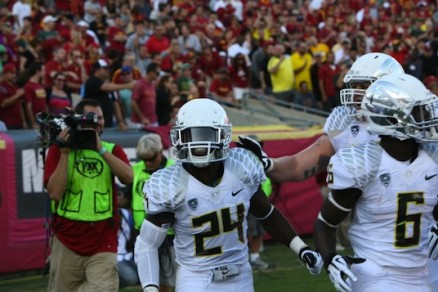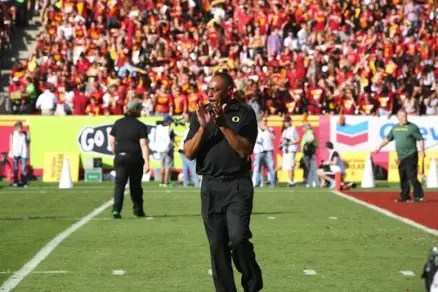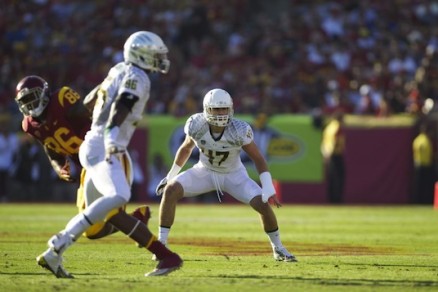This multi-week series will attempt to take a reasonable, logical and unbiased look at Oregon’s recent recruiting successes and failures while analyzing the program’s recruiting philosophy under Chip Kelly. The series will then look at how that philosophy already has and may continue to evolve under Mark Helfrich before ending with a detailed breakdown of the author’s ideal recruiting blueprint.
Part 1: What Happened in 2012-2013
Part 3: What Went Right: The Oregon Brand
The first five parts of this recruiting manifesto took a look at what HAS been and what WILL be; the next three parts look at what SHOULD be. This article gives a general overview of the ideal Oregon recruiting blueprint. Who should be pursued and how should Oregon pursue them? Those are the questions this article is attempting to answer.
The first thing to consider when constructing a recruiting blueprint is the level of talent that is reasonably attainable. You won’t find many janitors at the BMW dealership. Teams in low-talent areas without a winning tradition or notoriety for putting players into the NFL shouldn’t spend much time recruiting blue-chip talent. There are too many other, more attractive suitors. Now, there are obviously exceptions, but as a general rule, a team like Washington State would waste a lot of resources (time and money) trying to recruit four and five star players. So, where does Oregon stand?
Oregon is in a unique position in the world of college football recruiting. Eugene is located in a very talent-averse region of the country. The nearest pools of talent are 400 miles north near Seattle and 600 miles south in the Bay Area. That alone is a damning demographic; there is a reason that 90% of the top-15 teams in the recruiting rankings each year are located within 100 miles of a recruiting hotbed. Luckily for the Ducks, they’ve got other things going for them.
While Oregon isn’t known for its tradition or as an NFL pipeline, they are recognized as the sexiest team in college football. Chip Kelly took the program to a level of national recognition that few ever reach. Four straight BCS bowls, a historically explosive offense and transcendent jerseys have all helped to create one of the most powerful brands in college athletics. Say “Oregon” and people think of the words “fast”, “dominant”, “cool” and “sexy”. CEO’s around the nation would die to have their brands identified so positively. What this means with respect to recruiting is that every blue-chip recruit in the nation is aware of Oregon. The same can only be said of a handful of other programs. So, while Oregon might not have the tradition of some, their brand is so strong and relevant that it doesn’t really matter.
Thus, the level of talent reasonably attainable is of a high-caliber. Location does limit Oregon, and that will never change, but all that means is that the staff has to be selective in whom they target. One way to do this is by performing in-depth background checks and making sure that the players being pursued have the character desired by the staff. Another is to look at recruits who have significant interest in the program. So many recruits “like” or even “love” Oregon that the staff can’t possibly pursue them all. Now, if a significant number of these players were within 200 miles of campus, the staff could focus their collective attention on those kids, since, historically (and realistically) speaking, they’re the ones most likely to choose the program over another. That’s not the reality of the situation, though. Therefore, pursuing recruits with apparently genuine interest is key to avoiding a depletion of resources. It just isn’t possible for the coaches to pursue every tier-1 player who likes the program, but that’s ok. Garnering interest from too many elite prospects is a good problem to have.
While choosing to pursue players with genuine interest seems good on paper, in reality it’s more difficult than that. Big boards get constructed and a disproportionate amount of time and money is spent recruiting some players over others. How should these resources be split up? Well, there will always be unique situations, but in general, it would still be wise to pay attention to location. Two players may both be coveted, and both may have genuine interest, but if one is from Alabama and the other is from California, it’s not difficult to see which is more attainable. Again, there will always be unique cases, but in general, the majority of resources should be spent on recruits in the western United States. Note that majority doesn’t mean “all”.
Oregon’s recruiting approach needs to remain diversified because of the increased level of competition for California recruits. Oregon has always built its classes on a foundation of California prospects and that will likely never change, but competition is stiff. History tells us that battling USC for non-skill position Southern California players is incredibly difficult and usually ineffective. Additionally, the rapid ascension of the UCLA program under Jim Mora makes things even more difficult, since recruits who don’t choose USC (or aren’t offered by the Trojans) still have the option to stay close to home and play for a good team. Stanford’s continued success and Cal’s recent coaching change also provide challenges, particularly in Northern California. Don’t forget that Washington, while disappointing on the field, has a coaching staff full of proven recruiters. It’s also worth mentioning that teams like Ohio State, Notre Dame, LSU and even Alabama are targeting west coast players at a higher rate than ever before. California’s recruiting battlefield has become bloodier than ever.
Based on increased competition in California, Oregon should take advantage of their national brand and not shy away from recruits in all areas of the country. Even if the Ducks can land 3-4 more prospects from east of the Rockies than is typical, that will help to mitigate the increased competition out west. Given the love that blue-chip prospects around the country have for the Ducks, it’s certainly possible.
Now that we’ve looked at WHO should be pursued, the question is becomes HOW. The first critical step is establishing contact. Given the current recruiting landscape, making contact early in a recruit’s junior year is preferable, when possible. Some recruits don’t blossom until later on and that changes things, but the idea is to establish contact as soon as possible.
During the initial contact phase, coaches should pursue a large number of potential recruits. At this point, coaches still need to evaluate film, speak with players to gauge interest and if it gets that far, and look into a prospects background to help get a character evaluation. It’s not possible to do that on a large scale in a timely enough manner, meaning that gauging interest is critical. If there happens to be strong mutual interest, the relationship-building and evaluation processes can begin simultaneously.
Building relationships might be more important than anything else. A player’s relationship with a coach is often the deciding factor in his recruitment. This process should start after mutual interest is verified, usually during the spring of a prospect’s junior year (before the summer circuit begins). These relationships act to bridge the gap between the program and the recruit. While these relationships are fostered, the staff has time to more thoroughly evaluate a player and decide whether or not to extend an offer. Even if the staff decides to offer only as a back-up option, an on-going relationship with a member of the coaching staff might make it possible to avoid pursuing other, less-desirable options later in the cycle.
When an offer is made, the staff should pursue that player aggressively. An offer should mean that there is significant mutual interest. It means the staff wants said player after all evaluations are complete and feels the player has real interest in the program. Significant resources should be used to build a strong relationship with every prospect offered.
In summation, the recruiting blueprint laid out in this article looks like this:
- Identify desired blue-chip talent
- Establish contact with a large number of players
- Assess each player’s interest level in the program
- Begin building relationships with players who have genuine interest
- Evaluate players being pursued (based on talent, character and location)
- Decide whether or not to offer
- If offered, spend a significant amount of time and energy pursuing
- If not offered, but liked as a backup option, continue relationship-building process
Basically, the above strategy is to cast a wide net and then aggressively pursue prospects when offered. Additionally, don’t ignore back-up options, but rather continue fostering those relationships. Place an emphasis on character and focus on players in the Western United States, but don’t limit geographic footprint. In the coming weeks, we’ll look more closely at HOW to recruit, specifically, the logistical and social aspects of the recruiting process.
Related Articles:
Chip Kelly Update: Everything's Good Again ...
Chip Kelly Update: Wailing and Gnashing of Teeth
Shock and Awe -- The Oregon Ducks' Football Hangover Effect
Despite Lopsided Score, Georgia State "Never Stopped Believing"
Hope Springs Eternal for Ducks
Incompetent Pac-12 Officials: How Do You Miss ALL of THIS?
Chris was born in Montevideo, Uruguay, but made his way to Oregon by the age of five, when he attended his first game at Autzen Stadium. A huge sports fan at a young age, Chris grew up playing football, basketball and golf. Although realizing he isn’t likely to play in the NFL or NBA, Chris still holds on to hopes of being a professional golfer should his unfortunate putting woes take a turn for the better. A bit of a platypus, he attended both Oregon State and Oregon during his collegiate days where he earned a business degree in Finance and Business Administration. Chris works for Daimler Trucks North America in Portland, and plans to get his MBA from the University of Oregon.
Chris has been an active member in the recruiting community since 2005. He studies the intricacies of recruiting and is particularly intrigued by talent evaluation techniques. He is currently working on developing his own scouting reports for every scholarship player on the UO roster. Chris lives with his wife, Katrina, and his two-year-old son Lucas (a future dual-threat QB).

